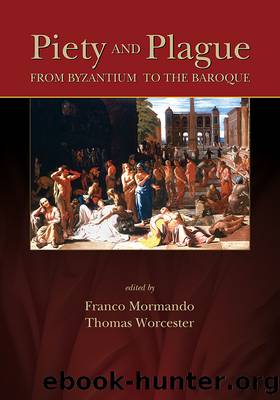Piety and Plague: From Byzantium to the Baroque by Franco Mormando Thomas Worcester & Thomas Worcester

Author:Franco Mormando,Thomas Worcester & Thomas Worcester [Mormando, Franco]
Language: eng
Format: epub
Tags: HIS037090 History / Modern / 16th Century
ISBN: 9781612480084
Publisher: TrumanStateUP
Published: 2015-11-05T06:00:00+00:00
[183] Fig. 7.2. Marcantonio Raimondi (after Raphael), Il Morbetto, ca. 1515-16. Engraving, Graphische Sammlung Albertina, Vienna, Austria. Photo reproduced by permission from the Albertina, Vienna.
Another recognizable plague motif is the man who pinches his nose to protect himself from the stench and perhaps also the infectious miasma surrounding him: this image is likewise found in many plague pictures of the time, including the influential Morbetto print. An additional motif is the pale gray skin of the dead mother, which recalls the pale face that is part of Cesare Ripaâs description of the personification of plague in his Iconologia.24 Although a physical detail such as the skin color of a plague victim can be understood as reflecting some contemporary medical knowledge of the plagueâs symptoms and effects,25 Poussinâs depiction does not intend to illustrate this medical data in any obvious or precise way. The artist, instead, employs almost exclusively those iconographic formulas and motifs that were already culturally encoded, irrespective of contemporary science. Thus, the figural groups in the foreground, composed of both the living and the dead, inevitably remind the viewer of previous plague representations. This is true as well of the middle-ground detail of the dead person being carried away.26
It is important to reiterate that, in deciding to represent the Philistinesâ disease as ârealâ plague, Poussin deviates from the traditional exegesis of his biblical subject, as seen in the discussion above of this ecclesiastical literature. The artistâs decision is all the more striking since, not only is this connection between plague and Ashdod not found in the aforementioned exegetical literature; it does not exist in the contemporary historical-medical-scientific literature on the plague either. The Plague of King David, the Plague of Pope Gregory the Great, and other historical and biblical epidemics are mentioned frequently in such treatises, but all reference to the [185]suffering of the Philistines is omitted.27 Among the many early modern plague treatises, there is only one reference to be found to the Philistinesâ disease as bubonic plague: this comes a few decades after the completion of Poussinâs painting, in Athanasius Kircherâs Scrutinium physico-medicum contagiosae luis.28 Though a unique case, Kircherâs reference does indicate that, by the later seventeenth century at least, interpretation of the Philistinesâ disease as a bubonic plagueâperhaps first proposed by Poussin in his paintingâwas a permissible as well as plausible deviation from traditionally accepted views. Poussin himself may have first had the idea of interpreting the Philistinesâ disease as the ârealâ plague while undertaking an initial survey of his textual sources and finding in translations of Josephus the repeated mentioning of the word âpesteâ (though there used with a different sense).
Inasmuch as Poussin has chosen a seldom-depicted biblical epidemic for the subject of his painting, and in doing so has decided to represent it, contrary to tradition, as ârealâ plague and, furthermore, does so in the form of a history painting destined for a collectorâs cabinet or gallery, the canvas can be considered highly unusual. Both its rare Old Testament subject and its
Download
This site does not store any files on its server. We only index and link to content provided by other sites. Please contact the content providers to delete copyright contents if any and email us, we'll remove relevant links or contents immediately.
Periodization Training for Sports by Tudor Bompa(8170)
Why We Sleep: Unlocking the Power of Sleep and Dreams by Matthew Walker(6618)
Paper Towns by Green John(5089)
The Immortal Life of Henrietta Lacks by Rebecca Skloot(4525)
The Sports Rules Book by Human Kinetics(4294)
Dynamic Alignment Through Imagery by Eric Franklin(4118)
ACSM's Complete Guide to Fitness & Health by ACSM(3989)
Kaplan MCAT Organic Chemistry Review: Created for MCAT 2015 (Kaplan Test Prep) by Kaplan(3940)
Introduction to Kinesiology by Shirl J. Hoffman(3726)
Livewired by David Eagleman(3684)
The Death of the Heart by Elizabeth Bowen(3552)
The River of Consciousness by Oliver Sacks(3540)
Alchemy and Alchemists by C. J. S. Thompson(3451)
Bad Pharma by Ben Goldacre(3356)
Descartes' Error by Antonio Damasio(3230)
The Emperor of All Maladies: A Biography of Cancer by Siddhartha Mukherjee(3066)
The Gene: An Intimate History by Siddhartha Mukherjee(3047)
The Fate of Rome: Climate, Disease, and the End of an Empire (The Princeton History of the Ancient World) by Kyle Harper(3003)
Kaplan MCAT Behavioral Sciences Review: Created for MCAT 2015 (Kaplan Test Prep) by Kaplan(2940)
